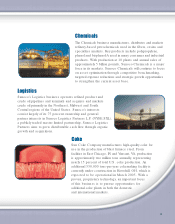Sunoco 2003 Annual Report Download - page 21
Download and view the complete annual report
Please find page 21 of the 2003 Sunoco annual report below. You can navigate through the pages in the report by either clicking on the pages listed below, or by using the keyword search tool below to find specific information within the annual report.
Logistics segment income decreased $7 million in 2003 largely due to $12 million of after-
tax charges for litigation associated with two pipeline spills that occurred in prior years,
partially offset by increased joint-venture income associated with assets acquired in 2002
(see below). In 2002, Logistics segment income decreased $9 million primarily due to
Sunoco’s reduced ownership interest in the Partnership subsequent to the February 8, 2002
initial public offering, partially offset by higher income from terminal facility operations.
During 2002, Sunoco recorded a $3 million after-tax charge to reflect the Partnership’s
write-off of a pipeline located in Pennsylvania and New York and a related refined prod-
ucts terminal that were idled because they became uneconomic to operate. This amount is
reported as part of the Asset Write-Downs and Other Matters shown separately in Corpo-
rate and Other in the Earnings Profile of Sunoco Businesses (see Note 3 to the con-
solidated financial statements).
In November 2002, the Partnership completed the acquisition from an affiliate of Union
Oil Company of California (“Unocal”) of interests in three Midwestern and Western U.S.
products pipeline companies, consisting of a 31.5 percent interest in Wolverine Pipe Line
Company, a 9.2 percent interest in West Shore Pipe Line Company and a 14.0 percent
interest in Yellowstone Pipe Line Company, for $54 million in cash. During September
2003, the Partnership acquired an additional 3.1 percent interest in West Shore Pipe Line
Company for $4 million, increasing its overall ownership interest in West Shore to 12.3
percent. In November 2002, the Partnership also completed the acquisition of an addi-
tional interest in West Texas Gulf pipeline for $6 million in cash, which increased its
ownership interest in this pipeline from 17.3 percent to 43.8 percent.
Coke
The Coke business makes high-quality, blast furnace coke at its Indiana Harbor facility in
East Chicago, IN and Jewell facility in Vansant, VA and produces metallurgical coal from
mines in Virginia primarily for use at the Jewell cokemaking facility.
2003 2002 2001
Income (millions of dollars) $43 $42 $61
Coke sales (thousands of tons) 2,024 2,158 2,002
Coke segment income increased $1 million in 2003 primarily due to higher coke prices at
Jewell and the absence of a $4 million after-tax write-off of accounts receivable from Na-
tional Steel Corporation (“National”) recognized in 2002 in connection with this former
long-term contract customer’s Chapter 11 bankruptcy filing. Partially offsetting these fac-
tors were lower tax benefits from Jewell coke operations largely due to the expiration of tax
credits for certain ovens effective January 1, 2003 (see below). As part of its bankruptcy
proceedings, National rejected its contract with Jewell. As a result, Jewell’s 2002 coke sales
were made into lower-value short-term markets. Coke segment income decreased $19 mil-
lion in 2002 due largely to the lower sales prices at Jewell and the accounts receivable
write-off. Partially offsetting these factors were higher sales volumes and related tax bene-
fits due to the liquidation of coke inventory at Jewell.
The Coke business has third-party investors in its Jewell and Indiana Harbor cokemaking
operations which are currently entitled to 98 percent of the cash flows and tax benefits
from the respective cokemaking operations during preferential return periods which con-
tinue until they recover their investments and achieve a cumulative return thereon that
averages approximately 10 percent after tax. Income is recognized by the Coke business as
coke production and sales generate cash flows and tax benefits which are allocated to
Sunoco and the third-party investors. The Coke business’ after-tax income attributable to
the tax benefits, which primarily consist of nonconventional fuel credits, was $38, $50 and
$48 million after tax in 2003, 2002 and 2001, respectively. In addition, expense is recog-
nized to reflect the investors’ preferential returns. Such expense, which is included in Net
19
























